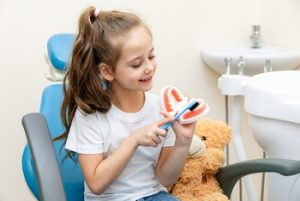Seeing your baby’s first tooth appear is an exciting milestone, but it also brings a fair share of questions and worries for many parents. Teething can feel like a bumpy ride, especially if you are not sure what is normal. Understanding a baby first tooth symptoms can help you support your little one through this important stage with more confidence and less stress.
Most babies start teething at around 6 months of age, although some may get their first teeth earlier or later. It is perfectly normal for babies to start teething as early as 4 months of age or as late as 12 months. Generally, the lower central incisors are the first to erupt, followed by the upper central incisors.
Let’s discuss what to expect from teething babies, how to recognise the signs, and how to soothe their discomfort.
What are the symptoms of a baby’s first tooth?
Every baby is unique, but there are some common teething symptoms to look out for. These include:
- Sore gums: Your baby’s gums may look red or swollen around the erupting tooth.
- Increased drooling: Teething stimulates more saliva production, so you might notice your baby’s mouth is wetter than usual.
- Biting and chewing: Many babies start sucking fingers, chewing on toys, or even biting while breastfeeding. This helps ease the pressure of an erupting tooth.
- Irritability: Teething pain can make babies fussy or unsettled, especially at night.
- Slight fever: Some babies develop slight or flushed cheeks when teething. A high fever is not considered a normal teething symptom and should be checked by your doctor.
- Disturbed sleep: The discomfort of teething may wake your baby more frequently.
- Changes in feeding: Some babies want to feed more to comfort themselves, while others refuse feeds because their gums are sore.
These symptoms usually start a few days before the tooth breaks through and settle once it has erupted.
Red and swollen gums: what to look for
One of the most reliable signs of teething is seeing red, swollen gums where the tooth will soon appear. Gently rubbing your baby’s gums with a clean finger or a cool, wet washcloth can help soothe them. You might even feel the outline of the tooth under the gum.
How to help a teething baby

- Give your baby a clean teething ring. Cool it in the fridge (never the freezer) for extra relief.
- Use a cold spoon for your baby to chew on if they are old enough.
- Gently rub your baby’s gums with a clean finger or wet washcloth to massage the sore area.
- Teething tablets and amber necklaces are not recommended due to concerns about choking hazards and safety.
- Comfort and cuddle. Sometimes, a little extra love and attention can be the best pain relief for a teething baby.
Is teething fever normal?
Many parents hear about teething fever and wonder if it is true. While a slight rise in temperature can happen with teething, anything over 38°C should be checked by your doctor, as another illness could cause it.
Caring for your baby’s first teeth
As soon as your baby’s first tooth appears, it is time to start caring for it. Baby teeth are important because they help your child eat, learn to speak, and keep space in the jaw for their adult teeth.
Here is how to keep your baby’s teeth healthy:
- Use a small, soft toothbrush with a smear of low-strength fluoride toothpaste
- Brush twice a day, especially before bed
- Once your baby has two teeth side by side, you can start gently cleaning between them with dental floss
- Never put your baby to bed with a bottle, as milk pooling around the teeth can cause tooth decay
- Take your baby to see a dentist by their first birthday
If you have concerns about fluoride toothpaste, check with your dentist about whether to use standard-strength or low-strength fluoride toothpaste.
What about fluoride varnish?
Your dentist might suggest applying fluoride varnish to protect your child’s teeth. This is a professional treatment that strengthens tooth enamel and helps prevent decay.
Other teething tips to keep in mind
- Avoid using teething necklaces or bracelets. These can be a potential choking hazard and are not recommended by paediatric dentistry associations.
- Be cautious with teething gels or teething tablets. Some over-the-counter products may contain ingredients unsuitable for babies.
- Offer a cool, wet washcloth for your baby to bite on under supervision.
Remember, the signs of teething can vary. Some babies show no symptoms except a new tooth popping through, while others have several days of discomfort.
When should you see a dentist?
Many parents wonder when to book their baby’s first dental visit. The Australian Dental Association recommends seeing a dentist by 12 months of age or within 6 months of the first tooth erupting. Early dental visits help spot any issues early and give you confidence in caring for your child’s teeth.
 Teething is a normal part of growing up.
Teething is a normal part of growing up.
Although teething can feel stressful, remember it is a normal part of your baby’s development. Most babies will have a few teeth by their first birthday, with the full set of 20 baby teeth usually in place by age three.
Supporting your baby through teething means lots of cuddles, comfort, and good oral hygiene from the very first tooth. If you ever feel unsure, do not hesitate to talk to your dentist.
Final thoughts
Baby first tooth symptoms can feel overwhelming, but with the right knowledge, you will be prepared to help your little one through this milestone. Gently rubbing their gums, using teething rings, and maintaining a consistent brushing routine with a pea sized amount of fluoride toothpaste can go a long way in keeping your baby’s mouth healthy and happy.
If your baby has any unusual symptoms like a high fever, persistent diarrhoea, or an ear infection, always see your doctor. Otherwise, remember that teething pain is temporary, and those precious new teeth will help your child smile, chew, and speak for years to come.
If you have any questions about your baby’s first tooth symptoms or caring for your child’s teeth, feel free to contact Infinity Dental Care on (02) 9159 6237 to book an appointment.
References
- Australian Dental Association. (n.d.). Australian Dental Association. Retrieved from https://ada.org.au/
- National Health Service. (n.d.). Baby teething symptoms. Retrieved from https://www.nhs.uk/baby/babys-development/teething/baby-teething-symptoms/
- Dental Health Foundation Ireland. (n.d.). Fluoride toothpastes. Retrieved from https://www.dentalhealth.ie/adult-oral-health/oral-health-care-products1/fluoride-toothpastes/


 Teething is a normal part of growing up.
Teething is a normal part of growing up.